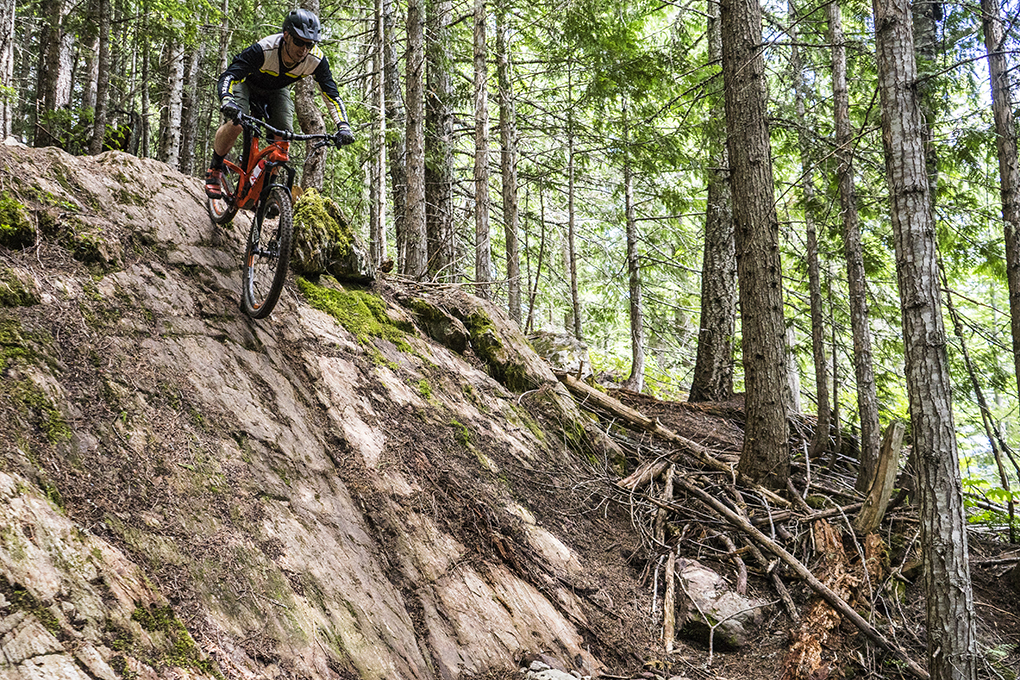
Race Face Turbine Dropper Post
Blister’s Measured Weights (30.9 mm / 150 mm drop):
- Post alone: 507 g
- Universal Thumb Lever: 27 g
- 1x Under Bar Lever: 60 g
- Full set up, as tested, including cable and housing: 629 g
Stated Features:
- Internal cable routing
- Infinite-adjust within stroke
- Race Face proven Hunter Head 2-bolt design
- Quick Connector allows easy, tool-free disconnection
- Left or right mount universal thumb lever remote (included)
- Functions at full capacity in below-freezing conditions (i.e. suitable for Fat Bikes & winter riding)
- 1x Front shifter style hop-up lever available in Black, Red, Blue, Green, Orange
Drop: 100 mm, 125 mm, 150 mm (tested)
Diameters: 30.9 mm (Reviewed), 31.6 mm
MSRP:
- Post with Universal Lever: $469.99
- 1X Under Bar Lever: $59.99
Bolted To: Evil The Following
Rider: 5’9”, 155 lbs
Test Locations: Montana, British Columbia
Test Duration: ~5 months
Intro
2016 will go down in the history books for all kinds of noteworthy events, and the most noteworthy is, of course, the fact that a whole bunch of companies released new and revised dropper posts. Race Face’s Turbine post is included in that mix, and I’ve spent most of this season putting time on it.
Measurements and Features
The Turbine is only compatible with frames that accept stealth / internal cable routing, but fortunately, most modern frames have internal routing as an option. The Turbine comes in 100 mm, 125 mm, and 150 mm drop versions, and I tested the 150 mm drop post.
The Turbine’s head is a well executed 2 bolt system — it’s essentially a more refined version of the head on a Rockshox Reverb. Beneath the head is the air valve for inflating post, and that’s protected by a rubber gasket.

A few measurements for those wondering if their legs are long enough to get away with a longer post: I measure the 150 mm drop post to be 214 mm from the bottom of the “collar” on the outer post, to the centerline of the saddle rails with the post fully extended.
In other words, with the post inserted all the way into the frame, the saddle rails will be 214 mm above the top of the seat tube with the seat in the up position. That measurement would be 189 mm for a Turbine with 125 mm drop, and 164 mm for a post with 100 mm drop. The collar at the top of the outer post is about 30 mm tall, and the clamping head is about 34 mm tall, so with the post fully inserted into the frame and dropped all the way, the saddle rails would be about 64 mm above the top of the frame’s seat tube.
It’s worth noting that those measurements are around 6-7 mm shorter than a Rockshox Reverb, so shorter folks might be able to get away with a longer drop with the Turbine.
Design
The Turbine uses a hydraulically actuated mechanical brake with an air return spring, which is a design licensed from 9point8. Basically, there’s an expanding cylinder that wedges against the inner walls of the post; when it’s expanded and wedged in, the post is locked in place. A hydraulic mechanism can contract that cylinder slightly, un-wedging it from the walls, and thus allowing the post to move up and down. That hydraulic mechanism is actuated by a regular derailleur cable.
So, in other words, you push the lever at the bar, and the cable pulls on a plunger inside the post. The plunger reduces hydraulic pressure which allows the cylinder to contract, which allows the post to move. Release the lever, and the cylinder expands again, locking the post in place.
This design is different from pretty much every other post on the market (with the exception of the 9point8 Fall Line), and it has some advantages. Most hydraulic posts on the market work similarly to the lockout on a fork. Basically, there’s a bunch of oil in the post that can flow between two chambers via a port. When the port is open, oil can flow from one chamber to the other, and the post can move. When the port is closed, oil can’t flow and the post is locked in place.

The reason this works is that oil isn’t compressible, so as long as the oil isn’t flowing, the post stays locked in place. The problem that these posts often run into is that, if a little bit of air works its way past the seals, all of a sudden you have a compressible gas in the chamber, and you get a squishy post — the seat sags a bit when you sit on it. This happens all the time in Rockshox Reverb posts, and it’s the reason you’re not supposed to pull up on the seat (doing so creates negative pressure which tends to suck air past the seals).
The difference in the Turbine is that the hydraulics aren’t what’s resisting the movement of the post – the collet / brake is. So when you pull up on the seat, it’s not creating a negative pressure scenario that can introduce air into the oil — you’re effectively just pulling on the mechanical brake.
Long story short: while it might sound like the inner workings of the Turbine are complicated, they’re actually pretty straightforward. And more importantly, the design solves one of the main durability issues that has plagued lots of dropper posts: air bubbles in the oil.
NEXT: Installation, The Ride, Etc.
